
By:
- Brittany Hook
Published Date
By:
- Brittany Hook
Share This:
Scripps Grad Students Bring Cutting-edge Science to Local K-12 Classrooms
Unique outreach program places Scripps students in diverse classrooms across San Diego County
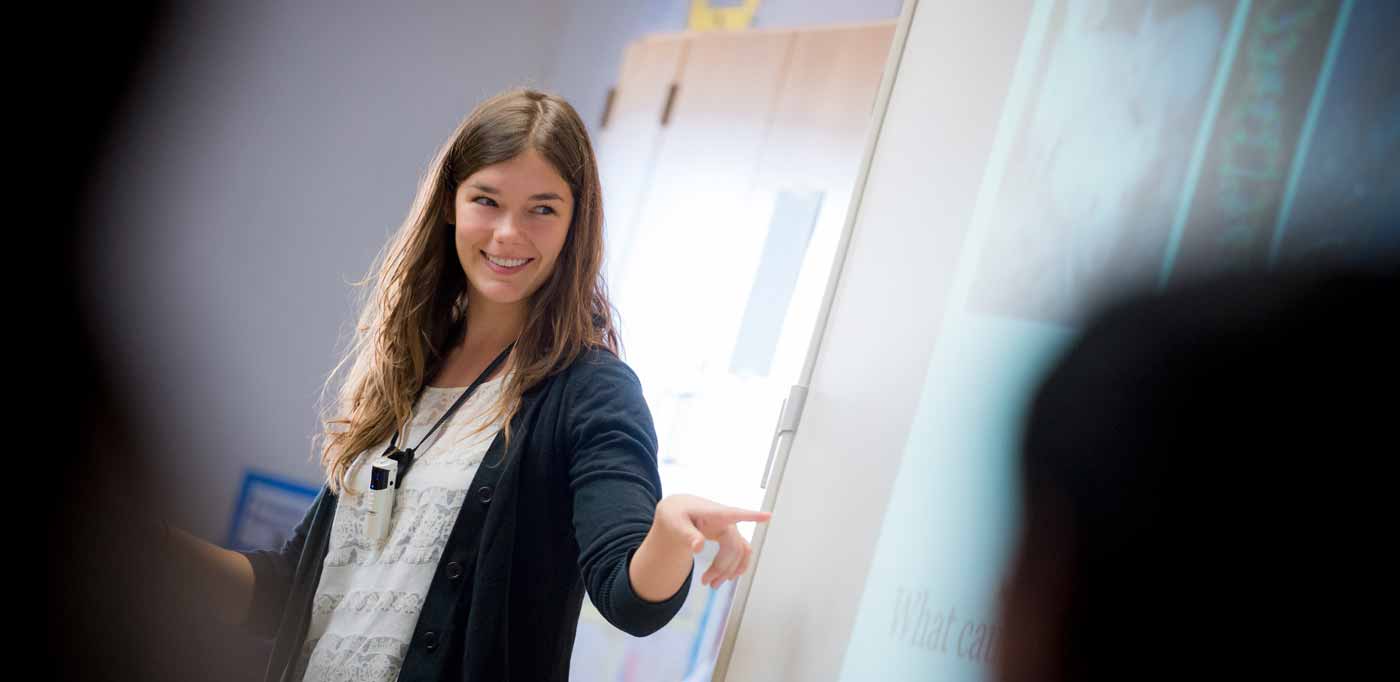
Scripps graduate student and Scripps Classroom Connection fellow Sarah Lerch instructs seventh grade students at Wangenheim Middle School in the Mira Mesa neighborhood of San Diego. Photos by Erik Jepsen/UC San Diego Publications
Ask any young student what a scientist might look like, and answers typically involve descriptions of older, frizzy-haired, bearded men wearing lab coats. A unique educational partnership between Scripps Institution of Oceanography at UC San Diego and the San Diego Unified School District directly challenges this notion by placing bright Scripps graduate students inside local K-12 classrooms.
In 2009, the National Science Foundation’s outreach program, Graduate Teaching Fellows in K-12 Education (GK-12), awarded Scripps Oceanography a five-year, $2.5 million grant to fund the Scripps Classroom Connection fellowship. Each year, Scripps Classroom Connection partners nine Scripps graduate students with nine teachers in K-12 classrooms across San Diego County. Over a four-week summertime workshop, Scripps graduate students collaborate with seasoned teachers to create yearlong lesson plans for earth science students.
Scripps research geophysicist and program co-director Hubert Staudigel understands the importance of reaching out to the community with programs such as Scripps Classroom Connection.
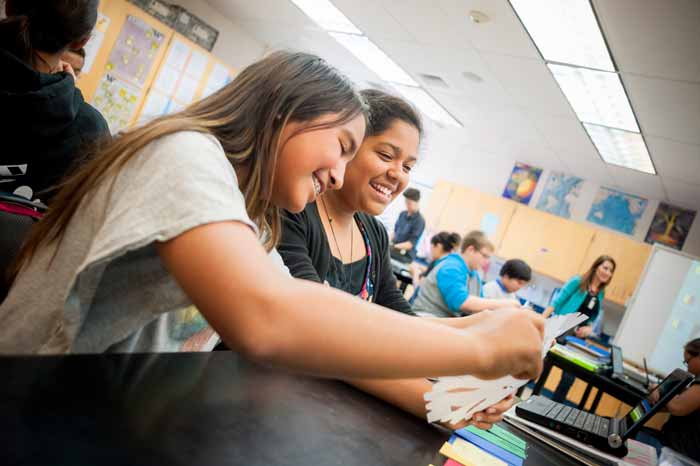
“I care deeply about education, and I feel as scientists, we owe it to the community to do this,” said Staudigel. “If you set up an environment of learning that is gradational from kindergarten all the way to graduate school, you can allow a student to go as far as their intellect takes them.”
In addition to improving earth science literacy in local classrooms and fostering connections between Scripps and the K-12 community, the Scripps Classroom Connection program allows budding early career Scripps scientists to learn valuable communications skills.
“They have to relearn how to communicate their science to a broader audience, and the benefit of that is to be able to talk to a congressman, or any donor,” said Staudigel. “It’s meant as a real professional development for our best students.”
Scripps graduate student and Scripps Classroom Connection fellow Sarah Lerch is currently working with science teacher Felicia Ryder and her seventh grade students at Wangenheim Middle School in the Mira Mesa neighborhood of San Diego. Lerch applied to the Scripps Classroom Connection program as a way to fine-tune both her teaching and communications skills, but this experience has proven to be mutually beneficial for herself and Ryder. “We’re working with great teachers; it’s not that they need better teachers to come in and help them,” said Lerch. “We’re learning how to teach from them and they’re benefitting from us by getting our expertise in whatever we research.”
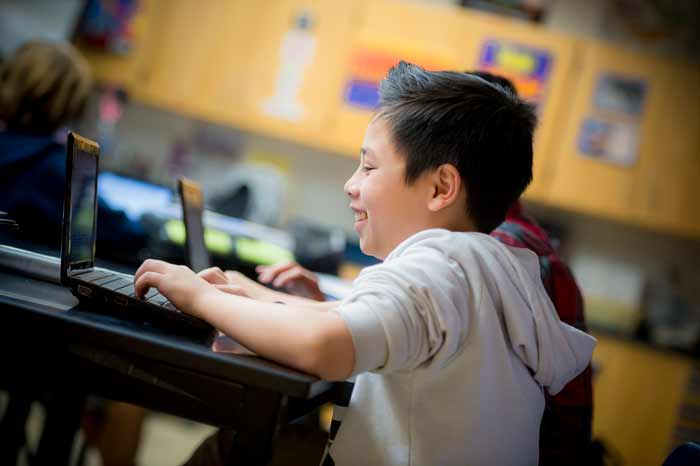
With her youthful appearance, tattooed arms, and outgoing personality, Lerch, 24, defies the common stereotype of what a scientist looks like. In fact, some students even joke with her that she looks like a 16-year-old. But the students pay attention to Lerch when she teaches, and many of them view her as a role model. “I’m surprised, like, at a young age she’s getting her Ph.D.,” said Tori, 12, one of Lerch’s students.
Ryder serves as a great mentor for Lerch, with more than 19 years of experience as a middle school science teacher. Ryder, who was named San Diego County Science and Technology Teacher of the Year in 2011, finds the Scripps Classroom Connection program to be extremely useful for her and the students. “It’s helped me to learn more, to keep my mind active and know what’s on the cutting edge, and it’s been helpful for the students because they get to learn from someone different,” said Ryder. “It’s always good to have multiple ways to learn.”
Empowering these seventh grade students with the knowledge that science is both interesting and approachable has been a major focus for Lerch. “When I was younger, a lot of my classmates viewed science as intimidating and scary, something that’s so hard,” said Lerch. “I’d like to make it more accessible and also show that there are young, normal, hopefully somewhat fun people that are in science and doing research and enjoying it.”
Growing up in Olympia, Washington, Lerch’s interest in marine biology was sparked by numerous family trips to the beaches near Puget Sound. As an undergraduate student at Western Washington University, Lerch took classes in both cellular biology and botany, but struggled to find a way to combine her two passions. All that changed when she took a class on algae and learned about diatoms, which are single-celled phytoplankton, and primary producers in the ocean. Primary producers are organisms that capture sunlight through photosynthesis, and they serve as the foundation of the aquatic food web.
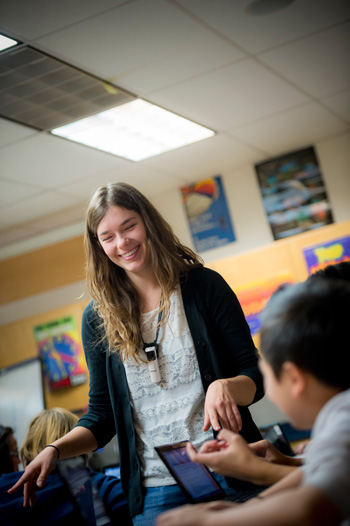
While investigating her newfound curiosity for diatoms, Lerch discovered that Scripps Oceanography houses a cutting-edge diatom research program, led by Mark Hildebrand in the Marine Biology Research Division (MBRD). After corresponding with Hildebrand about this innovative diatom research, Lerch realized that Scripps was a place where she could grow as a scientist, a graduate student, and a teacher. The positive mentorship provided by Hildebrand really cemented Lerch’s decision to pursue her graduate studies at Scripps Oceanography.
Lerch and other Scripps graduate students are currently studying diatoms in Hildebrand’s laboratory, with Lerch specifically researching the cell wall formation of diatoms for her Ph.D. Last summer, Lerch and Ryder collaborated to create a year’s worth of engaging lesson plans that would satisfy the California earth science teaching requirements, while also including a three-week unit on diatoms. “The big point of Scripps Classroom Connection is for us to bring our individual research into the classroom,” said Lerch, who spends an average of 13 hours per week in the classroom.
Just last week, Lerch began teaching her specialized unit on diatoms. Since diatoms aren’t commonly studied in middle school, Lerch had to begin growing diatoms in her Scripps laboratory and then physically transport them to Wangenheim, where the students were then able to grow them to a higher density. During an in-class activity, students used compound microscopes to count the number of cells on the slides in order to measure cell densities in the cultures.
Another in-class activity showed students the relationships between genes and proteins. Under Lerch’s guidance, each student constructed a paper model of a protein using a unique genetic code. This activity turned somewhat complex scientific information into something tangible.
“I used to think that you just got the way you look because one of your parents looked this way and the other looked another way and they just blended it, but now I know that there are different types of genes and now today I know that they make proteins, which is what affects their phenotype,” said Timmy, 12.
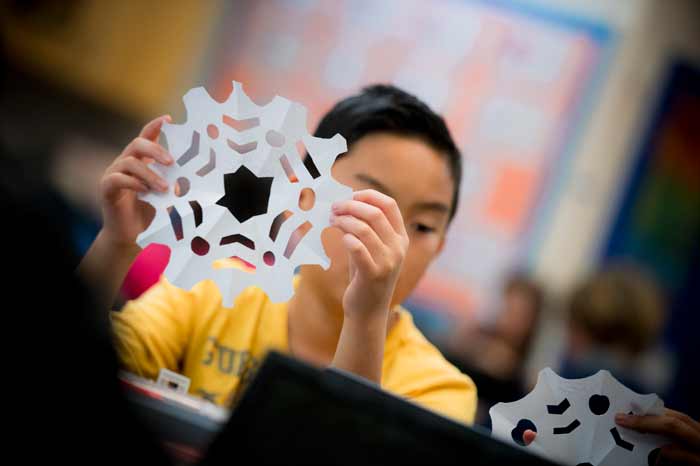
Receptive students such as Timmy highlight the profound impact that outreach programs such as Scripps Classroom Connection can have on young students (and perhaps future scientists). “I hope that they will see that they can do science, they can be a scientist,” said Ryder. “I hope that they’re inspired by this unit and its connections to the real world.”
Moira Décima, now a postdoctoral scholar at Scripps, also participated in the Scripps Classroom Connection program as a Scripps graduate student. After partnering with high school teacher Stephen Halpern, Décima worked with ninth and tenth grade earth science students at San Diego High School. Décima recalls her classroom experience as “eye-opening,” noting that some of the students—many of them San Diego natives—had never been to the beach. Funding from GK-12 and San Diego High School allowed Décima and Halpern to organize a classroom field trip to the tide pools in La Jolla. This hands-on research experience was yet another “first” for many students.
Décima and Halpern also collaborated to shift the way students thought about their own academic possibilities, especially in relation to science. On the first day of class, Décima, who was 29 at the time, pretended to be a fellow student, sitting among the masses as Halpern asked his students to describe and draw what a scientist might look like. Only one person drew a female scientist. Halpern then informed his students that a real Scripps scientist was sitting somewhere in the classroom, much to the students’ disbelief. After five long minutes, Décima revealed her true identity, which came as quite a shock to the students. “We wanted to challenge their conception of what they think of as a scientist, and also show them someone who’s not as far away from them,” said Décima. “It’s a very real possibility to become a scientist.”
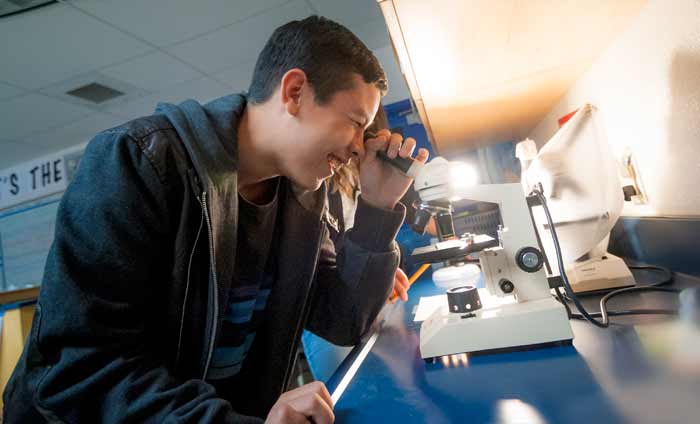
During the past 4½ years, 41 Scripps graduate students have participated in the Scripps Classroom Connection program, which has effectively reached the classrooms of 21 teachers at 10 different schools. (Many of the teachers have participated in the program for multiple years.) Countless students, many of whom come from socially and economically disadvantaged backgrounds, have also experienced the transformative effects of this educational Scripps program. Perhaps the most exiting aspect of the Scripps Classroom Connection program is “when a kid that is normally totally absent catches on fire, and we’ve had that happen a few times,” said Staudigel.
Scripps academic coordinator and Scripps Classroom Connection project co-director Cheryl Peach hopes that the first-hand experiences of Scripps students in local classrooms will be used to foster positive future changes in schools across the U.S., particularly in regards to science, technology, engineering, and mathematics (STEM) education. “It broadens their perspective on education in the U.S., and helps them better understand what the challenges are that are facing the teachers, the schools, the districts, and then the nation as a whole,” said Peach. “Our Scripps Oceanography graduate students are the best of the best, and they’re going to go on to positions where they will have impact.”
Although the Scripps Classroom Connection program has entered its final year, Staudigel and Peach aim to continue the project in some aspect.
“We’re hoping that we’ll be able to work to raise additional funds and to find strategies for continuing this in some sort of a modified way so it continues to have the impact both on the teachers and K-12 students,” said Peach.
Share This:
You May Also Like
Stay in the Know
Keep up with all the latest from UC San Diego. Subscribe to the newsletter today.


